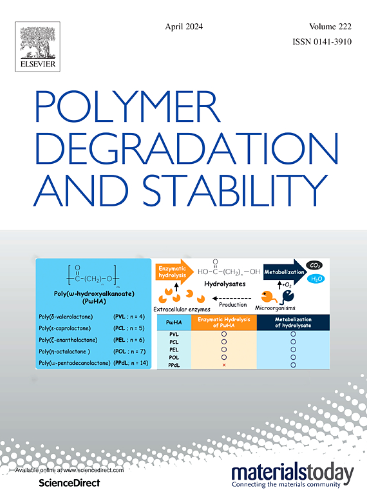以网纹草纤维和聚乳酸为基质的生物复合材料的崩解性和海洋生物降解性
IF 6.3
2区 化学
Q1 POLYMER SCIENCE
引用次数: 0
摘要
塑料在环境中的积累是一个公认的问题。为解决这一问题,人们开发了聚乳酸(PLA)等可生物降解材料。在土壤或水等自然环境中,聚乳酸的降解过程缓慢而稳定。为了加速材料的降解,本研究调查了以聚乳酸为基体、以网纹草纤维为增强材料的生物复合材料的降解情况。在海水/沉积物界面和海洋沉积物中进行了崩解和海洋生物降解性测试。采用了不同的测量测试来量化聚乳酸和复合材料样品的降解,重点是质量损失以及机械和热性能的变化。结果一致表明,与海洋生物降解性测试相比,解体测试中的质量损失和机械性能劣化程度更大。值得注意的是,与不含纤维的纯聚合物相比,复合材料的降解更为明显。就复合材料而言,与塑料基体相比,纤维的添加提高了生物降解性。本文章由计算机程序翻译,如有差异,请以英文原文为准。
Disintegration and marine biodegradability of biocomposite using Pennisetum setaceum fiber and PLA as matrix
The accumulation of plastics in the environment is a well-recognized issue. To address this, biodegradable materials such polylactic acid (PLA) have been developed. In natural environments such as soil or water, PLA degradation progresses slowly but steadily. To accelerate the degradation of the material, this study investigates the degradation of a biocomposite material using PLA as a matrix and Pennisetum setaceum fiber as reinforcement. Disintegration and marine biodegradability tests, both at the seawater/sediment interface and in marine sediment, were conducted. Different measurement tests were employed to quantify the degradation of PLA and composite samples, focusing on the mass loss and the variation of the mechanical and thermal properties. The results consistently demonstrated greater mass loss and mechanical property deterioration during the disintegration test compared to the marine biodegradability tests. Notably, the composite material exhibits more significant degradation than the pure polymer without fiber. For composite, the addition of fiber increased the degree of biodegradability compared to the plastic matrix.
求助全文
通过发布文献求助,成功后即可免费获取论文全文。
去求助
来源期刊

Polymer Degradation and Stability
化学-高分子科学
CiteScore
10.10
自引率
10.20%
发文量
325
审稿时长
23 days
期刊介绍:
Polymer Degradation and Stability deals with the degradation reactions and their control which are a major preoccupation of practitioners of the many and diverse aspects of modern polymer technology.
Deteriorative reactions occur during processing, when polymers are subjected to heat, oxygen and mechanical stress, and during the useful life of the materials when oxygen and sunlight are the most important degradative agencies. In more specialised applications, degradation may be induced by high energy radiation, ozone, atmospheric pollutants, mechanical stress, biological action, hydrolysis and many other influences. The mechanisms of these reactions and stabilisation processes must be understood if the technology and application of polymers are to continue to advance. The reporting of investigations of this kind is therefore a major function of this journal.
However there are also new developments in polymer technology in which degradation processes find positive applications. For example, photodegradable plastics are now available, the recycling of polymeric products will become increasingly important, degradation and combustion studies are involved in the definition of the fire hazards which are associated with polymeric materials and the microelectronics industry is vitally dependent upon polymer degradation in the manufacture of its circuitry. Polymer properties may also be improved by processes like curing and grafting, the chemistry of which can be closely related to that which causes physical deterioration in other circumstances.
 求助内容:
求助内容: 应助结果提醒方式:
应助结果提醒方式:


